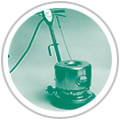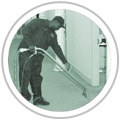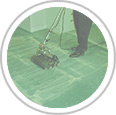
Rotary Shampoo
The carpet is cleaned by a rotary machine using a soft brush and a specially formulated neutral detergent. The brushing action is just enough to break the bond between soil and the carpet fiber, but gentle enough that it is less abrasive than a normal upright vacuum.
The detergent used is made under our name to our specifications and contains a soil retardant to help keep your carpet looking cleaner longer.
Shampoo cleaning became part of our service when synthetic detergents with built in soil retardant's were developed in the late 1940's, Renotex together with Bigelow Sanford, which was the largest carpet manufacturer at that time, developed procedures, equipment and chemicals for the rotary shampoo method. This method was so effective that other competing carpet manufacturers endorsed and recommended it on a wide spread basis.

